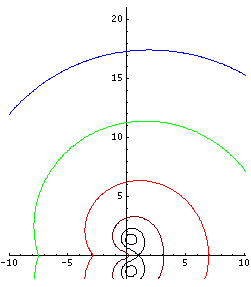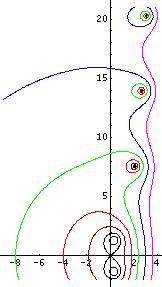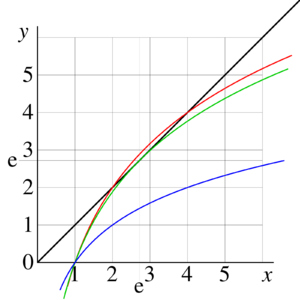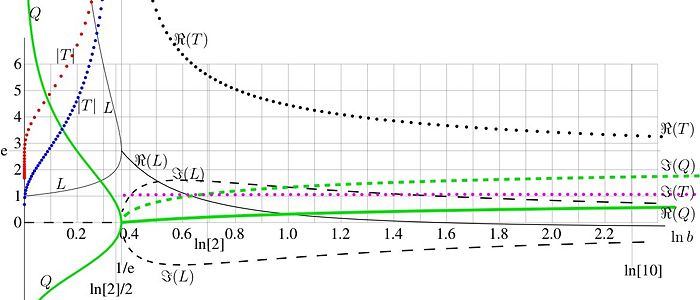Fixed point
A fixed point is a point in the domain of a function that is mapped to itself. Thus, a fixed point of a function f is a point x such that .
Examples
The squaring function is the function that maps each number to its square, so a fixed point of the squaring function is a number that equals its square. There are two such numbers: 0 and 1.
In similar way, 0 is fixed point of sine function, because .
The function f can also be a linear operator. In this case, the fixed point is an eigenvector with eigenvalue equal to unity. For instance, the exponential function is a fixed point of the differential operator because the derivative of ex is again ex. Similarly, the Gaussian exponential exp(−x2/2) is a fixed point of the Fourier transform operator defined by
Fixed points of exponential and fixed points of logarithm
Fixed points can be searched graphically. Fig.1 shows the graphical search of fixed points of logarithm, i.e., solutions of the equation
- (10)
There are no real solutions for this equation, but there are two complex-conjugated solutions and . However, the value of cannot be estimated well from the figure (1), but the straightforward iteration allows the precise estimate. Few hundreds of iterations are sufficient to get error of order of last significant figure in the approximation
- (11)
Fixed points of exp are not the same as those of ln
Fixed points of logarithm should not be confused with fixed points of exponential, shown in FIgure 2. These fixed points are solutions of equations
- (12)
They can be expressed also as solution of equation
- (13) for some integer
For example, at
- (13)
is fixed point of the exponential, but is not fixed point of natural logarithm.
In the case of exponential and natural logarithm, all fixed points are complex. However, the real fixed points exist at . For example, at , number e is fixed point of both, and ; and at , numbers 2 and 4 are their fixed points.
Finding of real fixed points is presented graphically in Figure 3. The black curve represents the identical function in the left hand side of equation
- (14)
the colored curves represent the function in the right hand side for , , and . In the last case, there are no real solutions, but the complex fixed points are complex numbers and . Within few hundred iterations of equation (14), they can be approximated with many decimal digits;
- (15).
Such evaluation can be performed in real time with any high level algorithmic language – Maple, Mathematica, that allow to specify number of correct decimal digits desirable in the result.
The mathematical proof of existence of the fixed points of the exponential can be found in the old paper by Helmuth Kneser [2]. Recently, Henryk Trappmann had generalized this proof for the exponentiation of arbitrary real base, but his theorem is not yet uploaded.
Tetration
The fixed points of logarithm determine the asymptotic properties of analytic extension of tetration . In some range of the complex -plane, the tetration can be approximated with asymptotic
(32)
where
(33)
and are fixed complex numbers, dependent on . Possible values of fixed points are shown with thin black curves versus logarithm on base . At , the fixed points are complex; the real part is shown with solid curve, the imaginary part is shown with dashed curve.
Green curves in Figure 4 represent the parameter in (33), again, the dashed curve shows the imaginary part, and real and imaginary parts of the asymptotic period . See article tetration for details.
Expression through the special functions
In some range of values of , and in particular, for , the fixed point of can be expressed through the LambertW function,
Function LamnertW is implemented in many programming languages.
The special name Filog is suggested for the function, that expresses one of the fixed point of logarithm through the logarithm of its base [3]:
Another fixed point can be expressed as
Function Filog is simply related with the Tania function:
This representation can be used in the whole complex plane; it is more robust than the representation above through the LambertW function.
Projectors
Functor on the space is called Projector, if for all .
Any function of subset of functions is fixed point of projector .
In common use are projectors of the 3-dimensional space to 2-dimensional space. Such projectors allow to make flat pictures of 3-dimensional objects. Any point at the plane of image is fixed point of such a projector.
Common fixed points
The same element may be fixed point of several functors.
Sometimes, such common fixed points can be approximated using iterations. If there are two projectors and , then the sequence of elements, approximating the common fixed point of these projectors can be constructed in the following way:
Such a sequence is used to approximate the amplitude-phase behavior of ultra-short pulses in the FROG systems [4][5]. Amplitude and phase in ultra-short pulses can be measured only with another ultra-short pulse; so, some nonlinear interaction is used to recover the temporal behavior of the pulse. The set of equations (usually two) is solved numerically, projecting the probe function to the spaces of solutions of each equation sequentially.
Notes
- ↑ The expression on the left-hand side means the value at p of the Fourier transform ; the Fourier transform is the result of applying the operator to the function f.
- ↑ Helmuth Kneser. "Reelle analytische Lösungen der Gleichung und verwandter Funktionalgleichungen". Journal für die reine und angewandte Mathematik 187: 8-67.
- ↑ http://tori.ils.uec.ac.jp/TORI/index.php/Filog is solution of the equation for base
- ↑ Rick Trebino, Kenneth W. DeLong, David N. Fittinghoff, John N. Sweetser, Marco A. Krumbügel, and Bruce A. Richman. Measuring ultrashort laser pulses in the time-frequency domain using frequency-resolved optical gating. Rev. Sci. Instrum. 68, 3277 (1997); DOI:10.1063/1.1148286
- ↑ Giulio Cerullo and Sandro De Silvestri. Ultrafast optical parametric amplifiers. Rev. Sci. Instrum. 74, 1 (2003); DOI:10.1063/1.1523642



={\frac {1}{\sqrt {2\pi }}}\int _{-\infty }^{\infty }f(x)\exp(-{\rm {i}}px)\,{\rm {d}}x.}](https://wikimedia.org/api/rest_v1/media/math/render/svg/0f7d05dbdca39ffb2bd527e085ca118e225581df)































































}](https://wikimedia.org/api/rest_v1/media/math/render/svg/017a97e3f0c147c2decb79f1d78e029f91ef95b3)
![{\displaystyle {\mathcal {F}}[f]}](https://wikimedia.org/api/rest_v1/media/math/render/svg/d84a4ecfeb48a40b6273d5b9e11c1bbe685455d8)



